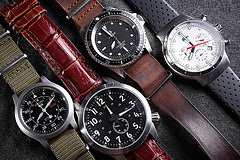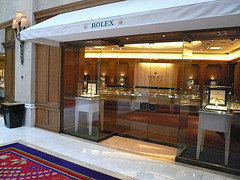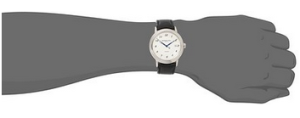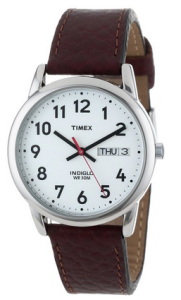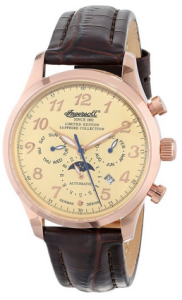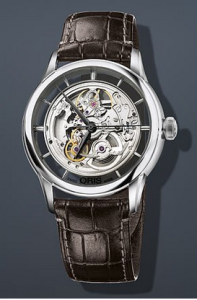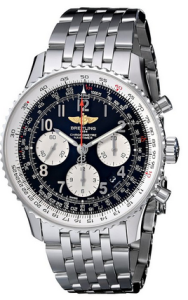So, you've read my post on why you should wear a watch, and you are sold that you shouldn't leave your wrist naked any more. Great! But now, where on earth do you begin when it comes to what watch to buy? A quick query through your favorite shopping website will find a multitude of watches of varying styles and prices, so it can be daunting to try and select one that fits your needs (and, more importantly, budget).
My other post on watches gave a bit of information on what styles to choose, but this will go into much more detail and hopefully get you on the right track. Most of these tips apply to men's watches, but some could be applied to women's as well (although keep in mind I don't know very much about women's watches).
Where to Buy a Watch:
Men's and women's watches are available at most jewelry stores, pawn shops, and, of course, watch brand stores. The upside of this approach is that you get to actually look at, touch, and generally observe the watch before you buy it. The downside is selection and price. Jewelry stores usually have a small selection of only a few brands, with prices probably a bit inflated. Pawn shops have a random selection with possibly good prices, but with the risk of secondhand watches being possible counterfeits (especially Rolexes). Watch brand stores will of course only have the one brand, but with the benefit of being an authorized retailer and probably a bigger selection of watches within that brand.
And then, there is of course the internet. It will definitely have the best selection and the best prices, with the downside of not being able to see the watch in person. So far the three watches I wear regularly have been bought on the internet (Amazon.com) and it is usually my go-to. If you are on a budget then I recommend at least starting here because it will probably offer watches within whatever price range you want to see. If you are going to buy an expensive watch (over $1000) from a luxury brand (Rolex, Breitling, Omega, etc.) then I would suggest buying from an authorized retailer to avoid the risk of the watch being counterfeit. If you want to save money and get one from a pawn shop or some other secondhand source, be sure to read up on how to spot a fake (some fakes are REALLY hard to spot) and go at your own risk.
How to Choose a Movement:
The movement of a watch is basically what makes it tick (literally). It is the heart of the watch and probably the most important functional aspect of the watch. For this reason it will have the most impact on the cost of the watch. There are basically three different types of movements, and I'll outline each below:
- Quartz: This will be your most accurate movement for the money. It works by sending an electrical current through a small piece of quartz crystal, which causes it to oscillate at a certain frequency due to the piezoelectric nature of quartz. This oscillation is then harnessed to make the watch tick. A tell-tale sign of a quartz watch will be that it ticks once per second, as opposed to a continuous movement of the second hand. Quartz is also the newest type of movement and has become quite popular due to its low cost and accurate time-keeping.
- Pros: Accurate and affordable
- Cons: Needs a battery that must be replaced every year or so (although some are solar powered)
- Mechanical, Hand-Wind: These watches use a spring that is compressed and then unwound very slowly, the force from which causes another spring to oscillate, and through a multitude of tiny little gears causes the watch to tick. The former spring is compressed by manually winding the watch, so for this reason the watch must be wound by hand on a daily basis.
- Pros: Does not need battery, so it can be left in a case for years and then brought back to life with a simple winding
- Cons: Can be very expensive, needs to be manually wound every day, less accurate than quartz
- Mechanical, Automatic Self-Wind: These work in basically the same way as the mechanical hand-wind, but have a rotor in the movement that turns with the motion of your wrist, which winds the watch automatically. That feature makes these watches more convenient than their manual cousins. With frequent wear, one would in theory never need to manually wind the watch.
- Pros: does not need to be wound if worn frequently
- Cons: Expensive, less accurate than quartz
That is a very abridged run-down of the three basic movements, but it should give you an idea as to what makes the watch tick. It should be noted that the mechanical watches are not necessarily less accurate than the quartz ones, but if you want a mechanical watch that is as accurate as a quartz one, you will have to pay dearly for it. This is what makes mechanical watches, on average, more expensive than quartz watches, and also one of the reasons they can be seen as status symbols.
So why would you want to buy a mechanical watch? Well, if you are a person that is nostalgic for the days before microchips ruled our lives, then you might like one. Or, if you appreciate fine craftsmanship and incredibly precise engineering, then you might like one. Or, if you like the look of a continuously sweeping second-hand, then you might like one. They are definitely the movement of choice for watch connoisseurs for those reasons.
Personally, I have 2 automatic self-wind watches (both fairly cheap, so they aren't super accurate), and one quartz watch (which is pretty accurate). They each serve different purposes for me and I love them all.
Water Resistance Rating:
Once you've decided on a movement, look at the second part of the "practical" end of the watch buying spectrum. First, ask yourself "what do I want to do with this watch?" If you want to be able to do recreational SCUBA diving in it, then you need one with at least 200m water resistance. If you are just going to wear it to the office and want something that won't break if it gets a little rain on it, then you can go with something with a 30m rating. These ratings aren't exactly intuitive (why would you need 30m water resistance if it just gets a little rain on it?), so it is handy to consult this article (especially the chart at the bottom).
Your desired water resistance will also determine your band style. If you want to swim or do anything that involves submerging the watch in water, then stick to metal or rubber/silicone bands, don't go with leather.
Case Size:
The size of the case is an important consideration for both practicality and aesthetics. On the practical side, the case diameter will determine how big the numbers on the face are and how easy it is to read the dial. The width of the case will determine how well the watch can be worn under the cuff of a long sleeved shirt. Thicker cases will have a harder time fitting, or will stick out, whereas thinner cases will slide in and out from under the cuff with ease.
Aesthetically, the watch case size will have a lot to do with the way the watch looks on your wrist. The size of your wrist will be the determining factor in the watch case sizes you can pull off. Men's watches today are getting increasingly large, which I don't really like because I have small wrists. If you are like me, don't wear a watch that is too big and completely engulfs your wrist, it will just make your wrist look even smaller. Likewise, if you have large wrists, don't wear a watch that is too small or else it will look like a women's watch. My theory on why men's watches keep getting bigger is that larger women's watches are becoming fashionable, so men's watches want to get bigger to make sure you can tell it is a men's watch. I think it's kinda stupid, but it is what it is.
Bottom line: just like a shirt, you don't want your watch to be too big or too small. For me, a 43mm case diameter is about the largest I can wear without it looking goofy, and most of the time I shoot for watches in the 40mm range. Watches smaller than 40mm used to be the norm for men, but now it is pretty difficult to find a good selection of these.
Here is also a handy guideline:
- Larger Diameter and Thicker Width: Sporty
- Smaller Diameter and Thinner Width: Dressy
Case Shape:
Personally, I think round is really the only shape to consider when getting a watch. Rectangular watches are fairly common, but I don't really like the look. The hands move around in a circle, so I think the case shape should reflect that. Otherwise it just looks weird.
Face Style:
Once you've decided on what type of movement you would like (or can afford) and you define your water resistance and case size requirements, you can get into the first of the "artsy" qualities of the watch. Watch faces can come in a ton of styles and colors, so it can be hard to sort through them all.
Classic Dial Colors/Styles:
- White: This is the simplest face color, and one that is widely accepted. Provides good contrast with black numbers/hands. I find pure white a tad boring, but if you are looking for a conservative and practical color, you can go with this. I would stick to leather bands when choosing a white dial, as metal doesn't provide a lot of contrast.
- Creme: I think creme/beige, when paired with black or brown leather bands, looks pretty darn classy. Still a very conservative color so it is widely accepted. I wouldn't go with a metal band for this color either, since it is still not a lot of contrast.
- Black/Dark Blue: My personal favorite (all the watches I wear have black dials), a black dial provides an excellent contrast with luminescent hands and numbers. For this reason it is probably a somewhat sportier color, so not as conservative as the white and creme dials, but still pretty safe to wear at most events. Also goes with pretty much any band material (especially metal), so very versatile.
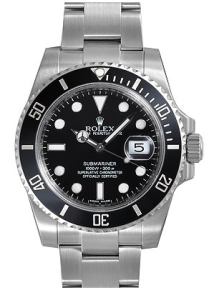
Black face with dots/ticks instead of numerals (also the watch of choice by the earlier James Bonds).
- Skeleton: This is reserved for mechanical watches only, it is a design in which there is no "face" per se, the inner gears and workings of the watch are left exposed. I think they look neat and are certainly pretty unique, but the downside is that they are usually pretty hard to read because the hands blend in with the gears.
Those are my go-to colors when surfing watches. They are pretty simple and "boring," but also timeless and safe for any occasion. Faces that dive into other colors (especially bright ones) start to get a little tacky looking, so be careful. Just like with clothes, if you go with timeless and conservative, you will avoid looking back at pictures of yourself 10 years down the road and utter "what was I thinking?"
Number Styles:
- Arabic: These are the simplest and easiest to read. Can be found on a variety of watches from sporty to formal. Pay special attention to the font, as fonts with more square or "bold" numbers give a sporty feel, while softer fonts give a "dressy" feel.
- Roman: Perhaps a bit harder to read if you aren't used to Roman numerals, but you will get used to it pretty quickly. I like Roman numerals on dressy watches, I think they give a bit of class to the face. I wouldn't choose it for a sports watch, though.
- Symbols: Many watches use some form of dots or tick marks in place of numbers. This is obviously less practical but has a distinctly simple and uncluttered look which can be visually appealing.
- None: Some watches get a bit too creative and decide to just forgo any sort of markings. I think it's kinda stupid, as it is both hard to read and gives the face a very barren appearance. If you like it, go for it, but I wouldn't.
Band Type:
The band has a lot to do in determining the overall appearance of the watch, and its formality level. It is obviously what people will see the most of when you expose your wrist, so you will want it to look good.
-Leather bands: These have the capability of being the most formal. A simple thin black leather band will be the most dressy, and can look really good with a creme colored watch face and silver or gold case. A brown leather band can also be pretty formal if it is not too thick. Brown leather bands that are really thick and/or have metal rivets in them are typical of pilot's watches, and can look really good with casual and business-casual clothing but should probably not be worn with formal clothing.
Overall, once leather bands are broken in they can be quite comfortable and can offer a great fit. Dressy leather bands might look a bit out of place with very casual clothing, and casual leather bands might look out of place with formal clothing, so they have a limited range of versatility.
-Metal Bands: These are more rugged and practical and are thus reserved for sports watches, in the classical sense. Due to the prevalence of classic sports watches such as Rolex and Breitling, and the fact that these come with large price tags, watches with metal bands have transcended the image of "sports watch" and are now pretty acceptable to wear in formal situations. Few people would see someone wearing a Rolex Submariner under a tuxedo and think he is under-dressed (James Bond did it, and you can too!).
That being said, not all metal bands are created equal. Most come with metal links that can be taken out to fit the wrist, but others have a sort of "chain mail" appearance which has a different look and feel. I think both styles are pretty comfortable, although sometimes my arm hair can get caught between the links and pulled out (ouch). As far as colors go, silver is classic, with a two-tone silver/gold or pure gold being more formal. Be careful with gold, as too much can look tacky. Also not recommended for young men. Black or dark grey metal bands have a distinctive sporty feel and can look pretty cool if done correctly.
Metal bands are probably the most versatile, as they can be worn with both casual and formal clothing and look pretty good. They are also fine to swim with (assuming the case has the approved water resistance), so they are practical as well. A downside is that with repeated use the links can get scratched, which is only very noticeable in bright light, but still takes away from the look. Another downside is the large prevalence of inexpensive metal band watches, so wearing one tends to make your watch blend in with everyone else's.
-Rubber/Silicone Bands: These are very durable and probably the best for watersports, but I say that you should keep them to that. They are very casual and shouldn't be worn with anything other than casual clothing. If you SCUBA dive or swim very often, then you might consider having one of these to use for those activities, but don't go into the office with one.
-Canvas Bands: These are pretty rare, so I don't really know a whole lot about them. Apparently they aren't as comfortable as you might think, and are definitely reserved for casual wear. I say don't get one unless you already have watches in the bands listed above and are looking to diversify.
Complications, Extra Features:
Once you've reached all the criteria listed above, you can look at the extra stuff. "Complications" is a term mostly used for mechanical watches that describes the different mechanisms needed for extra features. With mechanical watches, these can really drive up the price to sometimes ridiculous levels due to the difficulty of designing them, so keep that in mind.
- Date Display: I think this is a great feature for any watch to have. After wearing watches with the date on the dial for a few years, I now unconsciously look at my watch whenever I need to write down the date somewhere. It is relatively easy to implement so it doesn't drive the cost up too much, although the cheaper implementations will require you to manually set it for the months that have less than 31 days. I think that day of the month is all you need; some have day of the week or even month name, which I think is unnecessary and just clutters the dial.
- Rotating Bezel: Not technically a complication, but a great feature to have on any sportswatch. A rotating bezel allows you to spin the outer part of the dial and center the '0' where the minute hand is, which allows you easily tell the elapsed time. It's great for things like flying and SCUBA diving, and also just everyday things like timing your commute or how long your cake has been in the oven.
- Chronograph: This is a good feature when you want to time things with greater precision than a rotating bezel. Will usually drive up the cost quite a bit and also add several sub-dials to the display, giving a more cluttered look. If you can afford it, it is definitely nice to have if you frequently time things.
- 24 Hour Time/Zulu Time: A pretty common feature of pilot's watches, this display gives the time either in 24 hour format or the time in Greenwich, England. Useful for pilots or people that travel and cross time zones frequently. I have 24 hour dials on two of my watches and don't really ever look at them, but I guess they are handy if you take a really long nap and wake up not sure if it is day or night.
- Tachymeter: Also not technically a complication, but a series of numbers and ticks on perimeter of the dial that works in conjunction with a chronograph to tell speed based on a standard distance and elapsed time.
There are many more complications, as they are sort of a figure of merit by high-end watch manufacturers to see who can design the most complicated watch (prices for these watches can soar into the millions of dollars). For most normal people, the features listed above are all that you really ever need, and I would suggest sticking to those when starting out. Maybe one day you can get a mechanical watch that knows when it is a leap year and what the moonphase is, but now you should just stick to the most practical.
Examples:
I gave a lot of information to sort through, so you may be wondering where in the world your perfect watch would fit in the mix. I'll try to think of a few situations that I think many people can relate to, and give my recommendations for watches below.
1. The Blue Collar Man:
You're a hard working individual who isn't afraid to get down and dirty, but still likes to know what time it is and needs a watch that's as tough as you are. Even if you aren't on a tight budget, you still may not want to get a super expensive watch just because it will need to take a beating.
My recommendation: Quartz movement if you are on a budget with decent water resistance (50m-200m), a decently large case, a simple black dial with easy to read numbers, and a metal band (I think black would be a good choice since it looks pretty rugged and won't show dirt or grease as much).
2. The 9-5er:
You work in an office all day and probably wear business casual clothing. Your watch doesn't need to be very rugged, you just want something that will tell time and not break the bank.
My recommendation: Quartz if you are on a budget, but you could also dive into some mechanical movements if you want to stand out. Water resistance doesn't need to be much, case size should be average to small, dial color could be creme, white, or black (black if you want more sporty, creme if you want more dressy), and think about getting a brown or black leather band. To choose the band, think about what color shoes and belt you wear most of the time and get a color that matches. This will separate you from the Dilbert-esque guys that wear cheap digital watches to the office. Could also get a metal band if you want to do more rugged activities. Better yet, get a few watches with different bands!
3. The Executive: You don't know how to say it, but you're kind of a big deal. You want a watch that makes you look like the big deal you are, and you might have a few extra pennies to spend on it.
My recommendation: Mechanical movement, 30m water resistance, small to average case size, creme dial, silver or gold case, soft Arabic or Roman numerals or symbols, black leather band (since you will probably wear it with a suit most of the time).
4. The Pilot: You need a watch that is accurate and easy to read so that you can give your passengers arrival times with absolute confidence.
My recommendation: A pilot's watch! Mechanical movement (splurge on one that is accurate), or quartz if you are on a budget. Only need 30m water resistance, larger case with a black dial (for better contrast), bold Arabic numbers, and thick brown leather band (classic for a pilot's watch).
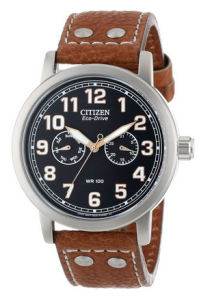
A Classic Looking Pilot's Watch
5. The Outdoorsman: You love to breathe in the fresh air and get back to your primal roots. You want a watch that can stand up to your extreme activities.
My recommendation: More or less the same as the watch for the Blue Collar Man, but with perhaps more water resistance.
6. The Status Seeker: You want people to think you are rich.
My recommendation: Go ahead and get a Rolex. They have done a great job of establishing a luxury brand, and pretty much anyone recognizes Rolexes as being expensive. Oddly enough, they are originally just a well made sportswatch, but the popularity of the brand made it into a status symbol (I think James Bond may have helped as well). They are also not the most expensive watches, but they are one of the more expensive brands that an average person could feasibly afford. If you want to take it up a notch, get a Patek Phillipe (more expensive than a Rolex), although many Americans are unfamiliar with the brand, so if you don't want to explain how expensive your watch is, then a Rolex would actually be a safer bet.
Also, I don't condone getting a watch to show off your status. If you get an expensive watch, do it because you appreciate the craftsmanship that goes into making them, not because you want people to think you are rich. More importantly, don't get a fake watch! If you can't afford a Rolex, don't get one. Don't pretend to be someone you're not. Wear whatever you can afford and don't be ashamed. At least you are wearing something.
I hope you found this useful in your watch buying endeavor. Wearing a watch is a great thing to make yourself feel more responsible and confident, and that will resonate with others as well. So go out and get yourself a great watch, and wear it with pride!
Photos (c) 2014 primenerd and (c) 2009 Michael Gray and shared under Creative Commons Attribution License 2.0 Generic
